

| Wren's rebuilding of the City churches (see Index) preceded at the same time he was occupied with the rebuilding of St. Paul's. Wren was given the opportunity to rebuild it after the medieval building had been destroyed in the Great Fire (although he had been involved in plans for its reconstruction even before 1666). St. Paul's Cathedral stands on the site of earlier cathedrals of the Diocese of London. Perhaps because of its long history, officials rejected the first two designs proposed by Wren (one in 1669 and the later so-called Great Model of 1673), largely because they deviated from the traditional basilica in plan. Additionally, since they were centralized plans, neither could be built in stages, an important criterion which would allow for financing the structure in increments. Finally, in 1675, the "Warrant Design" was accepted, a longitudinal plan but with a dome over the crossing. The cathedral is built of Portland stone from quarries at Dorset. This stone was believed to be the most durable in the London climate. | ||
Distant view of the side from the Millennium BridgeThe scale of St. Paul's Cathedral is immense, with the dome visible from various points in London. Here, the shorter tower to the left of the dome indicates the distance from the crossing/dome to the front west towers. |
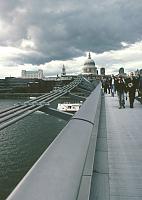
|
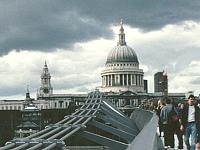
|

|
South transeptThe transepts are prominent (also see below) with pediments and semicircular porticos. According to Margaret Whinney, the semicircular portico is "almost certainly an adaptation of the facade of Santa Maria della Pace in Rome, and the pediment with a lunette in it may have come from the same source," (111) which Wren could have seen in engravings. | |
West frontDrawings exist which indicate that Wren was initially interested in designing a west front portico with giant columns extending through two stories. | ||
| Instead, because the quarries were unable to cut stone large enough, Wren's design was a compromise--still emphatic with paired Corinthian columns, but in two tiers, six pairs below and four above. The pediment above depicts in relief the conversion of St. Paul (1706) by Francis Bird, who also designed the statue of St. Paul at the apex of the pediment. | 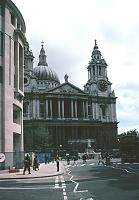
|
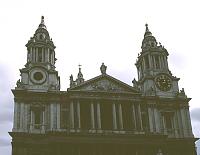
|
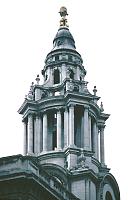
|
One of the west towersWhinney notes that these towers resemble Wren's late steeple designs, with columns surrounding a central core, "two visible above each face of the square tower below, while between them two further paired columns stand out over the angles of the tower" (115). (Contrast the simpler grouped column design in the tower of St. Stephen, Walbrook.) The ogee top is capped by a gilt copper pineapple. Not only are the transitions to the top effectively handled, but the tower's silhouette harmonizes with the dome. (See especially the distant view at the top of this page.) The undulations and dramatic use of light and shadow ally the tower design with Italian baroque architecture. The southern tower has a clock. | |
Left: nave wallsThe walls rise unbroken from the ground to the cornice, even though the side aisles flanking the nave on the interior are lower. These full height walls are essentially "false"; the upper wall has only "blind" windows and serves to mask flying buttresses which support the dome. Critics note that these full height walls add grandeur and proportion, serving aesthetically as an base for the dome.center: north transept; right: transept wallElegant coupled pilasters extend over two stories. The carved festoons linking the capitals owe to Inigo Jones' Banqueting House. | ||
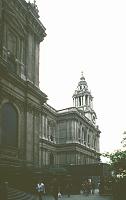 |

|
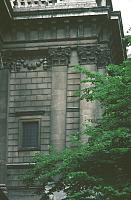
|
Detail of transept portico; round-headed windows with decorative carvings--figure heads, fruit, flowers, and foliage | ||
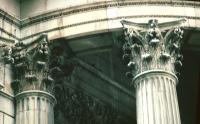
|
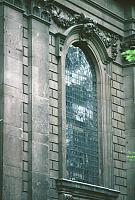
|

|
The dome--365 feet above ground levelThe drum, encircled by Corinthian columns with an entablature and balustrade, probably owes to Bramante's Tempietto in Rome. However, other elements are unique; solid walls with round-headed niches and panels at the top are spaced within every fourth column spacing. Above the drum Wren has added small square windows, flanked by pilasters. Vertical ribs lead to the lantern, a simpler version of the west towers with grouped columns. A ball and cross top the lantern. | ||

|
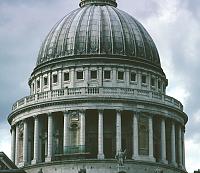
|

|
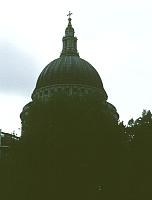
|

|
The dome is a feature in the London skyline--the most prominent until recently with the addition of enormous skyscrapers. It is even in one sights as one ascends the staircase to the Millennium Bridge | .
Works Cited:
Margaret Whinney. Wren. London: Thames and Hudson, 1971.
 Click here to return to index of art historical sites.
Click here to return to index of art historical sites.
 Click here to return to index of artists and architects.
Click here to return to index of artists and architects.
 Click here to return to chronological index.
Click here to return to chronological index.
 Click here to see the home page of Bluffton College.
Click here to see the home page of Bluffton College.
